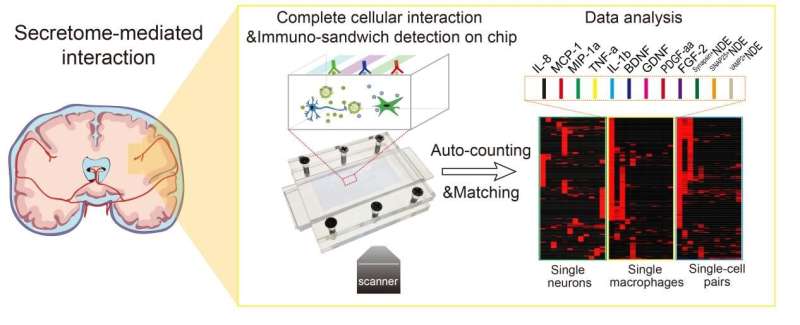Decoding the secretome-mediated neuron-immune cellular interaction network

Neuron cells are directly associated with neurodegenerative diseases. However, they are not isolated. They interact/communicate with surrounding cells through physical contact, the signal-ligand pathway, and other means to realize neural functions cooperatively.
Recent studies have shown that the nervous system and the immune system have close interaction/communication with each other, and the immune cells in the brain play a key role in shaping and regulating the neural function of neuron cells.
Now, a research team led by Prof. Lu Yao from the Dalian Institute of Chemical Physics (DICP) of the Chinese Academy of Sciences (CAS) decoded the secretome-mediated neuron-immune cell interaction network with single-cell integrative secretion profiling technology.
This study was published in PNAS on Oct. 26.
Although previous studies have analyzed the interaction between neuron-immune cells at the population cell level, the actual interaction/communication through multiple secretory factor signals in both physiological and pathological conditions are still unclear.
In this work, the researchers realized the mapping of 12 different secreted factors from high throughput single-neuron cells, including cytokines, neurotrophic factors, and neuron-derived exosomes, with single-cell integrative secretion profiling technology. They revealed the heterogeneity and correlation of different secreted factors in neuron cells.
Moreover, they applied the technology to paired neuro-immune single-cell interaction studies and found that infiltrating macrophages and resident macrophages (microglia) played different roles in neuronal secretion regulation. For example, infiltrating macrophages tended to inhibit neuronal secretion of neuron-derived exosomes, and microglia would promote neurosecretion in exosomes.
"We also find that the interaction of neuron cells with macrophages or microglia in the Alzheimer's disease model leads to increased secretion of pro-inflammatory cytokines," said Prof. Lu.
This study provides a new technology for in-depth understanding of the brain microenvironment, which helps discover markers for the occurrence and development of neurodegenerative diseases.
More information: Jiu Deng et al, Mapping secretome-mediated interaction between paired neuron–macrophage single cells, Proceedings of the National Academy of Sciences (2022). DOI: 10.1073/pnas.2200944119



















